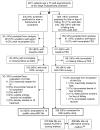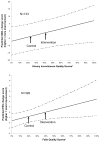Does better quality of care for falls and urinary incontinence result in better participant-reported outcomes?
- PMID: 21806560
- PMCID: PMC3654865
- DOI: 10.1111/j.1532-5415.2011.03517.x
Does better quality of care for falls and urinary incontinence result in better participant-reported outcomes?
Abstract
Objectives: To determine whether delivery of better quality of care for urinary incontinence (UI) and falls is associated with better participant-reported outcomes.
Design: Retrospective cohort study.
Setting: Assessing Care of Vulnerable Elders Study 2 (ACOVE-2).
Participants: Older (≥ 75) ambulatory care participants in ACOVE-2 who screened positive for UI (n = 133) or falls or fear of falling (n=328).
Measurements: Composite quality scores (percentage of quality indicators (QIs) passed per participant) and change in Incontinence Quality of Life (IQOL, range 0-100) or Falls Efficacy Scale (FES, range 10-40) scores were measured before and after care was delivered (mean 10 months). Because the treatment-related falls QIs were measured only on patients who received a physical examination, an alternative Common Pathway QI (CPQI) score was developed that assigned a failing score for falls treatment to unexamined participants.
Results: Each 10% increment in receipt of recommended care for UI was associated with a 1.4-point improvement in IQOL score (P = .01). The original falls composite quality-of-care score was unrelated to FES, but the new CPQI scoring method for falls quality of care was related to FES outcomes (+0.4 points per 10% increment in falls quality, P = .01).
Conclusion: Better quality of care for falls and UI was associated with measurable improvement in participant-reported outcomes in less than 1 year. The connection between process and outcome required consideration of the interdependence between diagnosis and treatment in the falls QIs. The link between process and outcome demonstrated for UI and falls underscores the importance of improving care in these areas.
© 2011, Copyright the Authors. Journal compilation © 2011, The American Geriatrics Society.
Figures


Comment in
-
Re: does better quality of care for falls and urinary incontinence result in better participant-reported outcomes?J Urol. 2012 Mar;187(3):967-8. doi: 10.1016/j.juro.2011.11.034. Epub 2012 Jan 21. J Urol. 2012. PMID: 22325523 No abstract available.
References
-
- Fatalities and injuries from falls among older adults--United States, 1993–2003 and 2001–2005. MMWR Morb Mortal Wkly Rep. 2006;55:1221–1224. - PubMed
-
- Cigolle CT, Langa KM, Kabeto MU, et al. Geriatric conditions and disability: the Health and Retirement Study. Ann Intern Med. 2007;147:156–164. - PubMed
-
- Anger JT, Saigal CS, Litwin MS. The prevalence of urinary incontinence among community dwelling adult women: results from the National Health and Nutrition Examination Survey. J Urol. 2006;175:601–604. - PubMed
-
- Anger JT, Saigal CS, Stothers L, et al. The prevalence of urinary incontinence among community dwelling men: results from the National Health and Nutrition Examination survey. J Urol. 2006;176:2103–2108. discussion 2108. - PubMed
-
- Cho CY, Alessi CA, Cho M, et al. The association between chronic illness and functional change among participants in a comprehensive geriatric assessment program. J Am Geriatr Soc. 1998;46:677–682. - PubMed
Publication types
MeSH terms
Grants and funding
LinkOut - more resources
Full Text Sources
Medical
Miscellaneous

